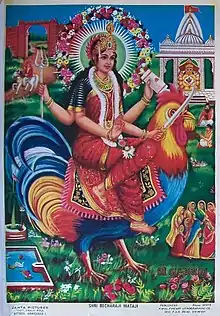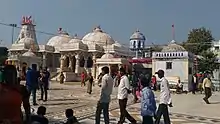Bahuchara Mata
The Bahuchara Mata (Hindi: बहुचरा माता, romanized: Bahucharā Mātā; Gujarati: બહુચર માતા, romanized: Bahuchara Mātā) is a Hindu goddess of chastity and fertility in her Maiden aspect, of the incarnation of the Hinglaj. Like other divinities in Gujarat and Rajasthan, Bahuchara is of Charan origin.[1] Devi Bahuchara was the daughter of Bapaldanji Detha. She is also considered the patroness of the hijra community.[2] Her primary temple is located in Becharaji town in Mehsana district of Gujarat, India.
| Bahuchara Mata | |
|---|---|
Goddess of innocence, Mercy, Kindness, Honesty, Sovereignty, self confidence, daughters, eunuchs, integrity and public welfare | |
 | |
| Other names | Bahuchar, Deval Suta Shasthi, Shaktiputri, Parashakti kanya |
| Affiliation | Devi, Shakti |
| Abode | Manidweep |
| Weapons | Devi mahatmya, trident, sword and rosary |
| Mount | Rooster |
| Festivals | Bahuchara navmi |
| Personal information | |
| Parents |
|
Bahuchara was worshipped by a dacoit of the Koli caste, Bapaiya, and her shrine was established by him under a Varakhada tree after her death in Shankhalpur.[3]
Depiction and symbols
Bahuchara was born in the Charan (Gadhvi) society. Devi Bahuchara was the daughter of Bapaldaan Detha. Bahuchara Mata is shown as a woman who carries a sword on her bottom left, a text of scriptures on her top left, the abhayamudra ("showering of blessings") on her bottom right, and a trident on her top right. She is seated on a rooster, which symbolises innocence.
One of the theories says that she is one of the goddesses in Sri Chakra. The real symbol of her vehicle is kurkut which means the serpent which has two mouths. Bahucharaji is seated on the low end and the other end goes to Sahasrara, which means that Bahucharaji is the goddess starting the awakening of kundalini which eventually leads the liberation or moksha.[4]
History and legends
According to the Kochar vyavahari ras, a poem written by Jain writer Gunavijaya in 1621, Bhils conducted animal sacrifice at the shrine to Bahuchara in a village near Sankhalpur in Chunval region. This was disturbing to a vaishya (merchant) named Kochar, who complained to the governor of Cambay, Sajanshi. Sajanshi brought this matter to the sultan of Gujarat, who made Kochar the governor of twelve villages including and around Sankhalpur. Kochar, now governor, ordered that animal sacrifice be stopped.[5]
According to Gadhavi Samarthdan Mahiya in 1935, Bahuchara was a Caran girl of the Dethe clan born in 1309 in Ujala, Marwad. Her father Bapal had obtained a jagir in Kathiawad, and her mother was an incarnation of Jagadamba. Upon her mothers death, Bapal called for Bahuchara and her two elder sisters. On the way they stopped overnight near Sankhalpur village in the Chunval region, where they were attacked by a Koli bandit named Bapaiya. Bahuchara then cut off her breasts and thus commited tragu, followed by her elder sisters Butay and Balal. She cursed Bapaiya to become a Pavaiyo (eunuch), to which he begged for mercy. Bahuchara ordered him to build a shrine to her, and if a "naturally emasculated man" wearing women's clothing and worshipping her, then they would achieve her blessings.[6][7][8][9]
Rammohanray Jasvantaray Desai in 1937 disputed this claim, saying the Charan claim to Bahuchara was ahistorical, and that Mahiya had overrellied on the account of Alexander Kinloch Forbes, who himself had taken the legend from the Charans. Desai claimed that the Charans were trying to appropriate Bahuchara, and that she was actually mentioned in the Puranas and was version of Shakti. He stated that pre-British and local theatrical traditions do not mention Charans or tragu, and that Charan accounts were not to be trusted due them being of low birth.[10]
According to legend, when a Muslim ruler invades the region, Bahuchara's chicken's tear themselves out of his soldier's stomachs to defeat the Muslim ruler. Early texts mentioning this legend are scarce on details, but according to R. J. Desai and Bhudharlal Gangaji Bookseller in 1919, the ruler was Alauddin Khalji. According to Bookseller, after the chickens tore themselves out of Alauddin's soldier's stomachs, he begged for foregiveness and Bahuchara created the Kamalia's from the soldiers, who wore a mustache on one side and bangles on the other.[11]
Temple

Bahucharaji Temple is located in Bahucharaji town in Mehsana district of Gujarat, India. It is 82 km from Ahmedabad and 35 km west of Mahesana. The original shrine was built by a king called Sankhal Raj in 1152 CE and the first surviving mention of the shrine was found in an inscription dating 1280 CE. According to the inscription no changes were made in the temple architecture until the eighteenth century.[12]
There are three shrines of the Goddess within the temple complex. The oldest part of the shrine complex termed 'Adyasthan' (the original site) is a small temple enclosing a sprawling, small-leafed varakhadi tree, believed to be the site where the goddess first appeared. Adjoining this is another small temple, the madhya sthan (second or intermediate place), which houses an incised plaque representing the goddess and has a locked silver door at its entrance. This part of the temple is believed to have been built by a Maratha named Fadnavis (or an official with that title) in the eighteenth century. In 1779 CE, Manajirao Gaekwad, the younger brother of the Maratha ruler of Baroda, built a third structure close to the original shrine after the goddess cured him of a tumor. The third is the main temple today and contains the Bala Yantra of quartz crystal representing the Goddess. Saint Kapildev and Kalari king Tejpal have also contributed to the construction and renovation of the temple. The temple complex is beautifully decorated with stone carvings and wall paintings. Though less well known outside of Gujarat and Rajasthan, the temple is considered a minor Shakti Peetha and every year about 1.5 million pilgrims visit this temple.[13]
Notes
- The Great Circle: Journal of the Australian Association for Maritime History. New Delhi, India, Asia: Australian Association for Maritime History. 1983. pp. 6: Bahuchara was a deified Charan lady, but the cult which developed around her probably also coalesced with an earlier one centred on a Koli goddess. 45 The main shrines of Bahuchara are located at Bahuchara, 30 miles south of Patan.
- Aditi Dharmadhikari (7 May 2015). "Bahuchara Mata's Story: A Hindu Goddess Worshipped By India's Transgender Community".
- Jayakar, Pupul (1989). The Earth Mother. New Delhi, India, Asia: Penguin Books. pp. 82: Bahuchara and her two sisters were attacked by Bapaiya, a Koli plunderer at Shakatpur. To save themselves from rape and abduction, the sisters killed themselves. Bahuchara cut off her breasts with the sword carried by Charana women and cursed him to be eunuch but she was requested by Koli dacoit and she asked him to worship her as a goddess and he did so. Koli dacoit established a shrine under varakhda tree and became staunch follower of her and worship till his death. ISBN 978-0-14-012352-4.
{{cite book}}: CS1 maint: date and year (link) - Yogi Ananda Saraswati (2012-08-20). "Devi: Bahuchara Mata". Retrieved 2015-11-03.
- Sheikh, Samira (2010). "The Lives of Bahuchara Mata". The Idea of Gujarat. Orient Blackswan. pp. 91–92.
- Gopal, Dr Krishna (2003). Fairs and Festivals of India. New Delhi, India, Asia: Gyan Publishing House. pp. 112 - 113: When his wife died, Bapal sent his servants to bring his children (Bahuchara and her sister) to Kathiawad from Marwar where they were staying. At Shankhalpur, where they halted for the night, Bapaiya, a Koli plunderer. ISBN 978-81-212-0811-6.
{{cite book}}: CS1 maint: date and year (link) - Jayakar, Pupul (1994). The Children of Barren Women: Essays, Investigations, Stories. New Delhi, India, Asia: Penguin Books. pp. 44: Bahuchara and her two sisters were attacked by Bapaiya, a Koli plunderer at Shakatpur, To save themselves from rape and abduction, the sisters killed themselves, Bahuchara cut off her breasts with the sword carried by Charana women. ISBN 978-0-14-024068-9.
{{cite book}}: CS1 maint: date and year (link) - Jayakar, Pupul (1980). The Earthen Drum: An Introduction to the Ritual Arts of Rural India. New Delhi, India: National Museum. pp. 68: Bapaiya Koli begged forgiveness, and the dying Chāraņa girl realizing that the Traga having been called forth could not be recalled, advised Bapaiya to install her as a goddess and worship her image . Bahuchara also promised that any.
{{cite book}}: CS1 maint: date and year (link) - Burman, J. J. Roy (2005). Gujarat Unknown: Hindu-Muslim Syncretism and Humanistic Forays. New Delhi, India, Asia: Mittal Publications. p. 80. ISBN 978-81-8324-052-9.
{{cite book}}: CS1 maint: date and year (link) - Sheikh 2010, p. 89-90.
- Sheikh 2010, p. 92-93.
- Samira Sheikh (2010). "The Lives of Bahuchara Mata" (PDF). The Idea of Gujarat. pp. 86–87.
- "Integrated Development Plan of Bahucharamataji Temple". Revenue Department, Government of Gujarat. Archived from the original on 2011-07-19. Retrieved 2007-11-28.
References
- Aggleton, Peter. Culture, Society and Sexuality: A Reader, Taylor & Francis 2007, p. 240 ISBN 041540455X
- Abbott, Elizabeth. A History of Celibacy, James Clarke & Co. 2001, pp. 329–330 ISBN 0718830067
- Ellingson, Stephen. Religion and Sexuality in Cross-Cultural Perspective, Routledge 2002 ISBN 041594127X
- Young, Serenity. Courtesans and Tantric Consorts, Routledge 2004, p. 111 ISBN 0415914833